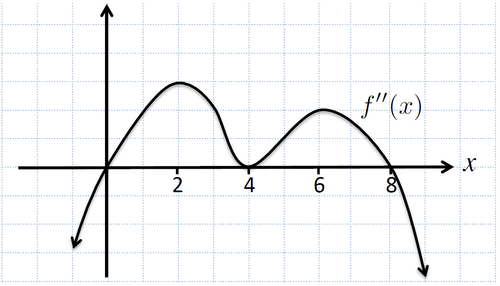Science:Math Exam Resources/Courses/MATH104/December 2015/Question 06 (b)
{{#incat:MER QGQ flag|{{#incat:MER QGH flag|{{#incat:MER QGS flag|}}}}}}
• Q1 (a) • Q1 (b) • Q1 (c) • Q2 (a) • Q2 (b) • Q3 (a) • Q3 (b) • Q3 (c) • Q4 (a) • Q4 (b) • Q4 (c) • Q5 (a) • Q5 (b) • Q5 (c) • Q6 (a) • Q6 (b) • Q7 • Q8 (a) • Q8 (b) • Q8 (c) • Q9 • Q10 (a) • Q10 (b) • Q10 (c) • Q10 (d) • Q11 •
Question 06 (b) |
|---|
|
The graph of (the second derivative of ) is displayed below. For what -value(s) does have an inflection point?  |
|
Make sure you understand the problem fully: What is the question asking you to do? Are there specific conditions or constraints that you should take note of? How will you know if your answer is correct from your work only? Can you rephrase the question in your own words in a way that makes sense to you? |
|
If you are stuck, check the hint below. Consider it for a while. Does it give you a new idea on how to approach the problem? If so, try it! |
Hint |
|---|
|
Recall that an inflection point of a function is a point at which changes sign, i.e., has a root and has opposite signs on either side of the root. In other words, changes its concavity (up/down) at an inflection point. Note that it is not sufficient for to merely have a root. |
|
Checking a solution serves two purposes: helping you if, after having used the hint, you still are stuck on the problem; or if you have solved the problem and would like to check your work.
|
Solution |
|---|
|
Following the hint, we see that changes sign at these are inflection points of Note: The point looks like an inflection point, but note that does not change sign there (and therefore does not undergo a change in concavity; it remains concave up). |
{{#incat:MER CT flag||
}}








